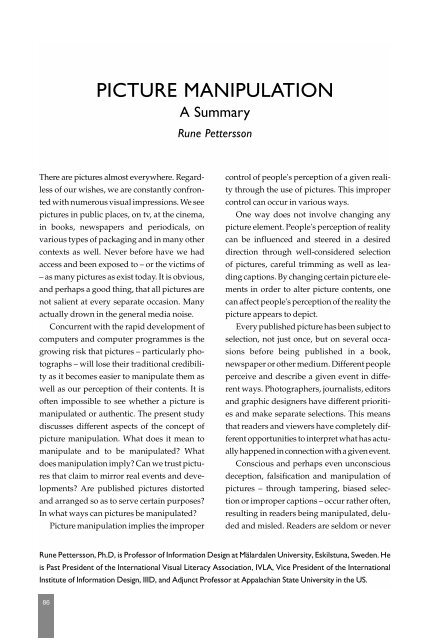BILDMANIPULERING
BILDMANIPULERING
BILDMANIPULERING
Create successful ePaper yourself
Turn your PDF publications into a flip-book with our unique Google optimized e-Paper software.
There are pictures almost everywhere. Regardless<br />
of our wishes, we are constantly confronted<br />
with numerous visual impressions. We see<br />
pictures in public places, on tv, at the cinema,<br />
in books, newspapers and periodicals, on<br />
various types of packaging and in many other<br />
contexts as well. Never before have we had<br />
access and been exposed to – or the victims of<br />
– as many pictures as exist today. It is obvious,<br />
and perhaps a good thing, that all pictures are<br />
not salient at every separate occasion. Many<br />
actually drown in the general media noise.<br />
Concurrent with the rapid development of<br />
computers and computer programmes is the<br />
growing risk that pictures – particularly photographs<br />
– will lose their traditional credibility<br />
as it becomes easier to manipulate them as<br />
well as our perception of their contents. It is<br />
often impossible to see whether a picture is<br />
manipulated or authentic. The present study<br />
discusses different aspects of the concept of<br />
picture manipulation. What does it mean to<br />
manipulate and to be manipulated? What<br />
does manipulation imply? Can we trust pictures<br />
that claim to mirror real events and developments?<br />
Are published pictures distorted<br />
and arranged so as to serve certain purposes?<br />
In what ways can pictures be manipulated?<br />
Picture manipulation implies the improper<br />
86<br />
PICTURE MANIPULATION<br />
A Summary<br />
Rune Pettersson<br />
control of people's perception of a given reality<br />
through the use of pictures. This improper<br />
control can occur in various ways.<br />
One way does not involve changing any<br />
picture element. People's perception of reality<br />
can be influenced and steered in a desired<br />
direction through well-considered selection<br />
of pictures, careful trimming as well as leading<br />
captions. By changing certain picture elements<br />
in order to alter picture contents, one<br />
can affect people's perception of the reality the<br />
picture appears to depict.<br />
Every published picture has been subject to<br />
selection, not just once, but on several occasions<br />
before being published in a book,<br />
newspaper or other medium. Different people<br />
perceive and describe a given event in different<br />
ways. Photographers, journalists, editors<br />
and graphic designers have different priorities<br />
and make separate selections. This means<br />
that readers and viewers have completely different<br />
opportunities to interpret what has actually<br />
happened in connection with a given event.<br />
Conscious and perhaps even unconscious<br />
deception, falsification and manipulation of<br />
pictures – through tampering, biased selection<br />
or improper captions – occur rather often,<br />
resulting in readers being manipulated, deluded<br />
and misled. Readers are seldom or never<br />
Rune Pettersson, Ph.D, is Professor of Information Design at Mälardalen University, Eskilstuna, Sweden. He<br />
is Past President of the International Visual Literacy Association, IVLA, Vice President of the International<br />
Institute of Information Design, IIID, and Adjunct Professor at Appalachian State University in the US.

















